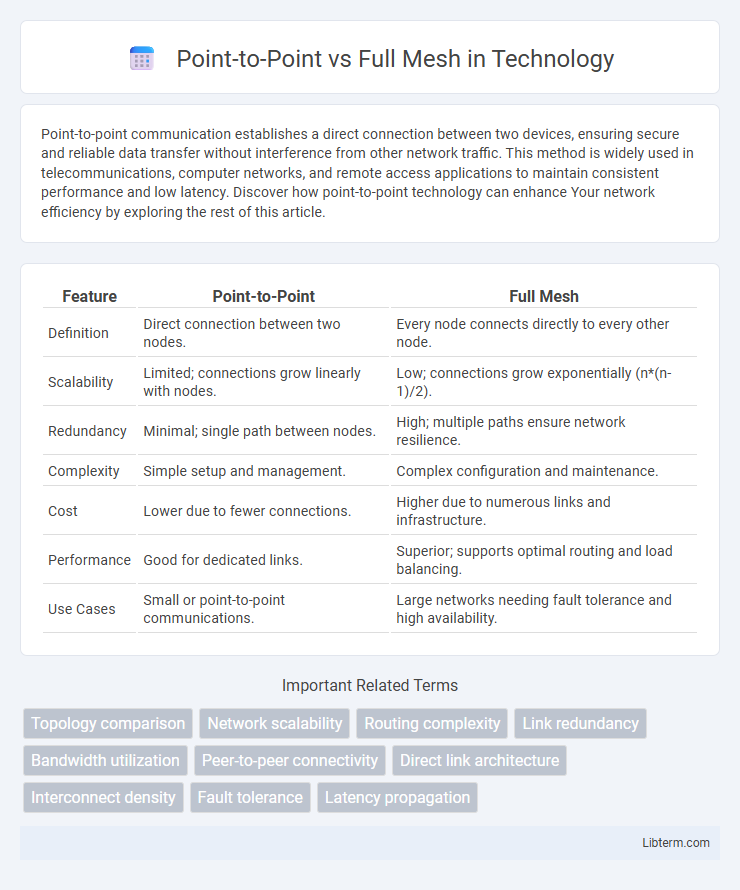Point-to-point communication establishes a direct connection between two devices, ensuring secure and reliable data transfer without interference from other network traffic. This method is widely used in telecommunications, computer networks, and remote access applications to maintain consistent performance and low latency. Discover how point-to-point technology can enhance Your network efficiency by exploring the rest of this article.
Table of Comparison
| Feature | Point-to-Point | Full Mesh |
|---|---|---|
| Definition | Direct connection between two nodes. | Every node connects directly to every other node. |
| Scalability | Limited; connections grow linearly with nodes. | Low; connections grow exponentially (n*(n-1)/2). |
| Redundancy | Minimal; single path between nodes. | High; multiple paths ensure network resilience. |
| Complexity | Simple setup and management. | Complex configuration and maintenance. |
| Cost | Lower due to fewer connections. | Higher due to numerous links and infrastructure. |
| Performance | Good for dedicated links. | Superior; supports optimal routing and load balancing. |
| Use Cases | Small or point-to-point communications. | Large networks needing fault tolerance and high availability. |
Introduction to Network Topologies
Point-to-point topology connects devices with a dedicated link, ensuring direct and reliable communication between two nodes, which simplifies troubleshooting and enhances security. Full mesh topology interlinks every device with all others, maximizing redundancy and fault tolerance while increasing complexity and cost. Choosing between these topologies depends on network size, performance requirements, and budget constraints.
Understanding Point-to-Point Architecture
Point-to-Point architecture establishes a direct link between two network nodes, ensuring dedicated bandwidth and low latency for data transmissions. This design simplifies communication paths, reduces protocol overhead, and enhances security by limiting data exposure to only the connected devices. Compared to Full Mesh, Point-to-Point scales more efficiently in small networks but may become less manageable as the number of required connections increases exponentially.
Exploring Full Mesh Topology
Full mesh topology provides a robust network structure by connecting each node directly to every other node, reducing latency and improving fault tolerance. This architecture enhances data redundancy and ensures continuous communication even if multiple links fail, making it ideal for mission-critical applications. While point-to-point connections offer simplicity, full mesh maximizes reliability and performance in complex network environments.
Key Differences Between Point-to-Point and Full Mesh
Point-to-Point topology connects each device directly to one other device, offering simplicity and minimal cabling but limited redundancy. Full Mesh topology links every device to all others, ensuring maximum redundancy and fault tolerance at the cost of higher complexity and increased cabling requirements. Key differences include scalability, where Point-to-Point suits small networks, and Full Mesh supports large, mission-critical systems with superior reliability.
Advantages of Point-to-Point Networks
Point-to-Point networks offer a direct, dedicated communication link between two nodes, ensuring high-speed data transfer with minimal latency and reduced interference. They provide enhanced security by limiting access points and simplify network management due to fewer devices and straightforward configuration. Cost efficiency is achieved as Point-to-Point setups require less hardware compared to complex Full Mesh networks, making them ideal for targeted, reliable connections.
Benefits of Full Mesh Topology
Full mesh topology enhances network reliability by providing multiple redundant paths between devices, minimizing the risk of single points of failure. This architecture ensures optimized data routing and reduces latency, improving overall network performance and resilience. Scalability is supported through direct connections among all nodes, facilitating efficient communication in complex and high-demand environments.
Use Cases for Point-to-Point vs Full Mesh
Point-to-Point connections are ideal for linking two specific locations with dedicated, high-performance communication channels commonly used in private WANs and simple branch office setups. Full Mesh topology suits environments requiring robust redundancy and low latency between multiple nodes, often deployed in large enterprise networks and data centers for critical applications. Use cases for Point-to-Point emphasize cost-efficiency and straightforward setup, while Full Mesh supports mission-critical systems demanding continuous uptime and multiple communication paths.
Scalability and Performance Considerations
Point-to-Point networks offer straightforward scalability by adding direct links between specific nodes, but this approach can lead to increased complexity and reduced efficiency as the number of connections grows exponentially. Full Mesh topologies provide superior performance and redundancy by connecting every node to every other node, ensuring low latency and high fault tolerance, but they face significant scalability challenges due to the exponential increase in required links and associated costs. Choosing between Point-to-Point and Full Mesh depends on balancing network size, budget constraints, and performance requirements, with Full Mesh best suited for smaller, latency-sensitive environments and Point-to-Point favored for larger or more segmented networks.
Cost Implications and Maintenance
Point-to-Point networks typically incur lower initial costs due to simpler infrastructure requiring fewer connections and less hardware, making them cost-effective for limited device setups. In contrast, Full Mesh networks demand significantly higher investment because every node connects directly to all others, increasing cabling, equipment, and complexity. Maintenance expenses also escalate in Full Mesh configurations, as troubleshooting and managing numerous connections require specialized skills and prolonged efforts compared to the straightforward upkeep of Point-to-Point links.
Choosing the Right Topology for Your Network
Choosing the right network topology between Point-to-Point and Full Mesh depends on factors like scalability, cost, and redundancy requirements. Point-to-Point topology offers simplicity and lower expenses with direct connections between devices, ideal for small or linear networks. Full Mesh topology provides high fault tolerance and robust connectivity through direct links among all nodes but incurs higher implementation and maintenance costs suitable for mission-critical systems.
Point-to-Point Infographic

 libterm.com
libterm.com